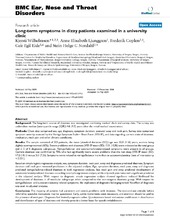Long-term symptoms in dizzy patients examined in a university clinic
Wilhelmsen, Kjersti Thulin; Ljunggren, Anne Elisabeth; Goplen, Frederik Kragerud; Eide, Geir Egil; Nordahl, Stein Helge G.
Peer reviewed, Journal article
Published version
Permanent lenke
https://hdl.handle.net/1956/4035Utgivelsesdato
2009-05-16Metadata
Vis full innførselSamlinger
Originalversjon
https://doi.org/10.1186/1472-6815-9-2Sammendrag
Background: The long-term course of dizziness was investigated combining medical chart and survey data. The survey was undertaken median (interquartile range (IQR)) 4.6 (4.3) years after the initial medical examination. Methods: Chart data comprised sex, age, diagnosis, symptom duration, postural sway and neck pain. Survey data comprised symptom severity assessed by the Vertigo Symptom Scale – Short Form (VSS-SF), and data regarding current state of dizziness, medication, neck pain and other chronic conditions. Results: The sample consisted of 503 patients, the mean (standard deviation (SD)) age was 50.0 (11.6) years, women being slightly overrepresented (60%). Severe problems with dizziness (VSS-SF mean (SD) 13.9, (10.8)) were indicated in the total group and in 5 of 6 diagnostic sub-groups. Vertigo/balance- and autonomic/anxiety-related symptoms were present in all groups. Current dizziness was confirmed by 73% who had significantly more severe problems than the non-dizzy (VSS-SF mean (SD): 17.2 (10.1) versus 5.0 (7.3)). Symptoms were related to vertigo/balance more than to autonomic/anxiety (test of interaction p < 0.001). Based on simple logistic regression analysis, sex, symptom duration, neck pain, sway and diagnoses predicted dizziness. Symptom duration and neck pain remained predictors in the adjusted analysis. Age, symptom duration, neck pain, sway and diagnoses predicted vertigo/balance-related dizziness in both regression analyses. Sex, neck pain and sway predicted development of autonomic/anxiety-related dizziness according to simple regression analysis, while only neck pain remained a significant predictor in the adjusted analysis. With respect to diagnosis, simple regression analysis showed significant reduced likelihood for development of dizziness in all vestibular sub-groups when compared to the non-otogenic dizziness group. With respect to vertigo/balance- and autonomic/anxiety-related symptoms, the implication of diagnostic belonging varied. No effect of diagnoses was seen in adjusted analyses. Conclusion: The majority of patients had persistent and severe problems with dizziness. The wait-and-see attitude before referral to specialist institutions may be questioned. Early, active movements seem necessary, and attention should be paid to the presence of neck pain. Diagnoses had limited prognostic value. Questionnaire-based evaluations could assist in classification and identification of type of dizziness and thereby provide a better basis for specific rehabilitation.
Utgiver
BioMed CentralOpphavsrett
Wilhelmsen et alCopyright 2009 Wilhelmsen et al; licensee BioMed Central

